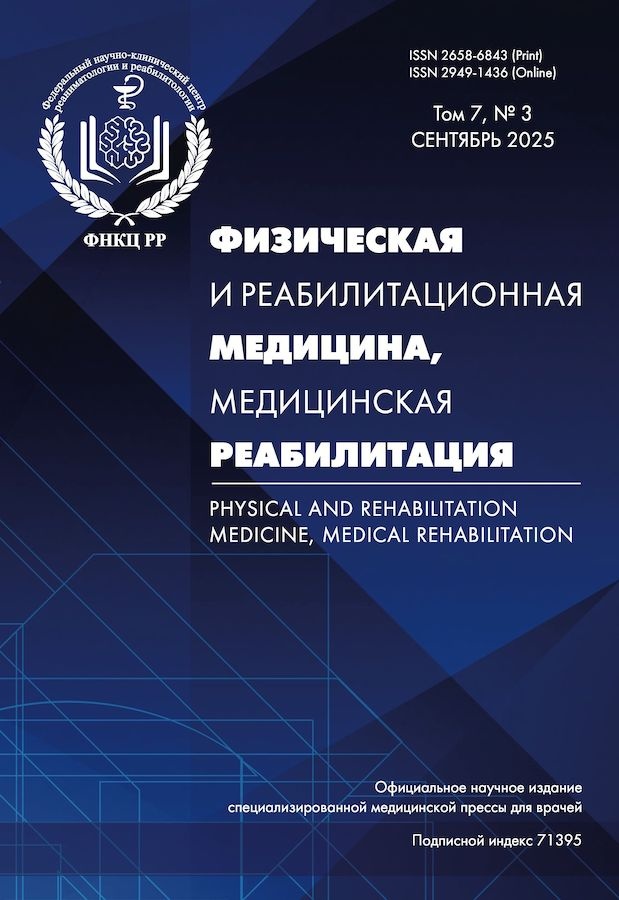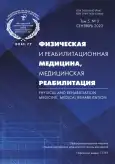Динамика ультрасонографической картины кожи и подкожной клетчатки при физиотерапевтическом лечении целлюлита методом компрессионной микровибрации: нерандомизированное проспективное исследование
- Авторы: Кардашова З.З.1, Селезнева Е.В.1, Ратникова Н.О.1, Василенко И.А.1,2
-
Учреждения:
- Московский областной научно-исследовательский клинический институт имени М.Ф. Владимирского
- Российский государственный университет имени А.Н. Косыгина (Технологии. Дизайн. Искусство)
- Выпуск: Том 5, № 3 (2023)
- Страницы: 227-236
- Раздел: ОРИГИНАЛЬНОЕ ИССЛЕДОВАНИЕ
- URL: https://bakhtiniada.ru/2658-6843/article/view/253820
- DOI: https://doi.org/10.36425/rehab568644
- ID: 253820
Цитировать
Полный текст
Аннотация
Обоснование. Для эффективного устранения целлюлита и улучшения внешнего вида кожи предлагается широкий выбор методов, однако его лечение остаётся одной из самых трудно решаемых задач в эстетической медицине. Весьма ограничен арсенал средств, позволяющих объективно оценить возможности косметических и эстетических терапевтических мероприятий.
Цель исследования ― оценка эффективности применения метода компрессионной микровибрации для коррекции структурных и функциональных изменений кожи у женщин разных возрастных групп с гиноидной липодистрофией.
Материалы и методы. Проведено одноцентровое нерандомизированное проспективное исследование эффективности метода компрессионной микровибрации (Endospheres Therapy) у 27 женщин с лёгкой и умеренной гиноидной липодистрофией в возрасте от 40 до 69 лет под контролем ультрасонографического исследования кожи до начала лечения, после 12 процедур и через 2 месяца после курса терапии. Для ультразвукового исследования кожи использовали специализированную цифровую ультразвуковую систему высокого разрешения DUB SkinScanner (TPM GmbH, Германия), оснащённую датчиком 75 МГц с разрешением 21 мкм и глубиной сканирования от 4 до 6 мм. Дополнительно делали антропометрические измерения, рассчитывали индекс массы тела.
Результаты. Динамика значений индекса массы тела выявила тенденцию к снижению веса у большинства участниц. Окружности бёдер и талии у участниц в возрасте 40–49, 50–59 и 60–69 лет уменьшились на 3,0±1,1 и 5,3±1,1, 2,2±0,9 и 4,1±1,3 и 2,5±0,9 и 6,3±1,5 см соответственно. Установлено, что после курса Endospheres Therapy у пациенток 1, 2 и 3-й возрастных групп в областях передней, внутренней, задней поверхности бедра и передней поверхности живота снизилась толщина дермы на 15,6, 9,5 и 18,1%; 10,9, 10,5 и 19,3%; 6,1, 15,7 и 13,8%, 23,4, 14,7 и 14,5% (p <0,05) соответственно; увеличилась эхогенность дермы в областях передней, внутренней, задней поверхности бедра и передней поверхности живота в 2, 1,4 и 1,3; 1,2, 1,4 и 1,2; 1,4, 1,4 и 1,5; 1,3, 1,5 и 1,7 раза (p <0,05) соответственно. Эхогенность гиподермы снизилась в исследуемых областях на 30,8, 27,6 и 31,2% (p <0,05); 20,1, 37,3 и 40,4% (p <0,05); 43,2, 57,8 (p <0,05) и 9,3%; 23,6, 15,2 (p <0,05) и 9,3% соответственно. Эффект сохранялся через 60 дней после курса терапии.
Заключение. Полученные результаты убедительно продемонстрировали эффективность методики Endospheres Therapy у женщин с лёгкой и умеренной гиноидной липодистрофией для коррекции фигуры и улучшения состояния кожных покровов в долгосрочной перспективе, не выявив каких-либо побочных эффектов.
Ключевые слова
Полный текст
Открыть статью на сайте журналаОб авторах
Зивер Заиддин кызы Кардашова
Московский областной научно-исследовательский клинический институт имени М.Ф. Владимирского
Автор, ответственный за переписку.
Email: kard-dina@yandex.ru
ORCID iD: 0000-0003-0095-1706
SPIN-код: 7806-8613
канд. мед. наук
Россия, МоскваЕлена Владимировна Селезнева
Московский областной научно-исследовательский клинический институт имени М.Ф. Владимирского
Email: selezneva-elena@mail.ru
ORCID iD: 0000-0002-6181-9031
SPIN-код: 9748-6169
канд. мед. наук
Россия, МоскваНаталья Олеговна Ратникова
Московский областной научно-исследовательский клинический институт имени М.Ф. Владимирского
Email: ratnikova.natalya@gmail.com
ORCID iD: 0009-0009-6568-5286
Россия, Москва
Ирина Анатольевна Василенко
Московский областной научно-исследовательский клинический институт имени М.Ф. Владимирского; Российский государственный университет имени А.Н. Косыгина (Технологии. Дизайн. Искусство)
Email: vasilenko.ia0604@yandex.ru
ORCID iD: 0000-0002-6374-9786
SPIN-код: 6611-9990
д-р мед. наук, профессор
Россия, Москва; МоскваСписок литературы
- Bennardo L., Fusco I., Cuciti C., et al. Microwave therapy for cellulite: An effective non-invasive treatment // J Clin Med. 2022. Vol. 11, N 3. P. 515. doi: 10.3390/jcm11030515
- Павельев Ю.В. Причины возникновения целлюлита и основные методы воздействия на него // Вестник науки и образования. 2020. Т. 88, № 10. С. 100–105.
- Плиева Л.Р. Cellulitis против cellulite // Российский журнал кожных и венерических болезней. 2015. Т. 18, № 6. С. 42–49.
- Young V., Di Bernardo B.E. Comparison of cellulite severity scales and imaging methods // Aesthetic Sur J. 2021. Vol. 41, N 6. P. NP521–NP537. doi: 10.1093/asj/sjaa226
- Tokarska K., Tokarski S., Woźniacka A., et al. Cellulite: A cosmetic or systemic issue? Contemporary views on the etiopathogenesis of cellulite // Postepy Dermatol Alergol. 2018. Vol. 35, N 5. P. 442–446. doi: 10.5114/ada.2018.77235
- Bass L.S., Kaminer M.S. Insights into the pathophysiology of cellulite: A review // Dermatol Surg. 2020. Vol. 46, Suppl. 1. P. S77–S85. doi: 10.1097/DSS.0000000000002388
- Stevens W.G., Green J., Layt C., et al. Multicenter pivotal study demonstrates safety and efficacy of a new cellulite procedure: 3-Month results // Aesthet Surg J. 2023. Vol. 43, N 1. P. 97–108. doi: 10.1093/asj/sjac179
- Layt C. A study of a novel controlled focal septa release method for improving cellulite // Plast Reconstr Surg Glob Open. 2022. Vol. 10, N 4. P. e4237. doi: 10.1097/GOX.0000000000004237
- Arora G., Patil A., Hooshanginezhad Z., et al. Cellulite: Presentation and management // J Cosmet Dermatol. 2022. Vol. 21, N 4. P. 1393–1401. doi: 10.1111/jocd.14815
- Hogan S., Velez M.W., Kaminer M.S. Updates on the understanding and treatment of cellulite // Semin Cutan Med Surg. 2018. Vol. 37, N 4. P. 242–246. doi: 10.12788/j.sder.2018.056
- Piotrowska A., Czerwińska-Ledwig O., Stefańska M., et al. Changes in skin microcirculation resulting from vibration therapy in women with cellulite // Int J Environ Res Public Health. 2022. Vol. 19, N 6. P. 3385. doi: 10.3390/ijerph19063385
- Christman M.P. Belkin D., Geronemus R.G., Brauer J.A. An anatomical approach to evaluating and treating cellulite // J Drugs Dermatol. 2017. Vol. 16, N 1. P. 58–61.
- Cristovam D.N., Botelho S., Andrade M.F., et al. Whole-body vibration in the reduction of the cellulite // J Cosmet Laser Ther. 2019. Vol. 21, N 5. P. 278–285. doi: 10.1080/14764172.2018.1525750
- Sadowski T., Bielfeldt S., Wilhelm K., et al. Objective and subjective reduction of cellulite volume using a localized vibrational massage device in a 24-week randomized intra-individual single-blind regression study // Int J Cosmet Sci. 2020. Vol. 42, N 3. P. 277–288. doi: 10.1111/ics.12613
- Pilch W., Czerwińska-Ledwig O., Chitryniewicz-Rostek J., et al. The impact of vibration therapy interventions on skin condition and skin temperature changes in young women with lipodystrophy: A pilot study // Evid Based Complement Altern Med. 2019. Vol. 2019. P. 8436325. doi: 10.1155/2019/8436325
- Metelin V.B., Fomicheva A.A., Kardashova Z.Z., et al. Evaluation of the effectiveness of non-invasive methods of compressive microvibration and ablative sensory microvibration on local areas with excess fat deposits in volunteers of different age groups // J Applied Cosmetol. 2023. Vol. 41, N 2. P. 74. doi: 10.56609/jac.v41i2.278
- Кардашова З.З., Ратникова Н.О., Василенко И.А., Фомичева А.А. Компрессионная микровибрация: опыт применения метода для физиотерапевтического лечения целлюлита // Физиотерапия, бальнеология и реабилитация. 2022. Т. 21, № 6. С. 391–400. doi: 10.17816/rjpbr403993
- Безуглый А.П., Бикбулатова Н.Н., Круглова Л.С., и др. Особенности ультрасонографической картины кожи и подкожной клетчатки при целлюлите // Физиотерапевт. 2015. № 1. С. 3–7.
- Бондаренко И.Н. Сравнительный анализ ультразвукового исследования кожи высокочастотными датчиками // Радиология ― практика. 2021. № 6. С. 22–30 doi: 10.52560/2713-0118-2021-6-22-30
Дополнительные файлы










